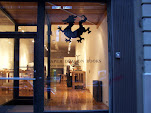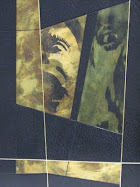



......so, i got some response to my first items, one of them asked for a deeper explanation of the tooling process .
At work today I had to finish a book for a friend, and I took pics along the way.........
Veterans amoung you will know that an attempt to explain tooling in 1 blog post would be pure folly, but what i can offer is an explanation of what I did today, in one instance, on one book....
Its a cute little red book, palm size, so I`m going to use my 8pt edinburgh to letter, and do some simple single pallets above and below the raised bands......
First, i gotta burnish the book, its small so i can do it using hot plates in the kensol......very quick, very effective.
I paste wash the skin, and tool the lettering and lines in blind .
After glairing up the blind impressions, it is decided that i will use 2 methods for completing the gold work.......
First I will tool the lines, by picking up the gold on the brass pallet.Rub my nose, run the nose grease along the pallet, pick up a chopped line of gold, and drop it in.
I have found that this is best so far, as it avoids filling-in over the bands, and any unnecessary cleaning.
Second, applying the leaf directly to the surface for the lettering using a layer of grease.
The tooling is completed, and grease removed, leaving a simple but rich finish...
One note, you may have noticed the rather cumbersome glove I`m wearing on my left hand.
This is of course enables me to position the tool without burning my fingers(Michael Wilcox uses a thumb cover made of leather , vis , his video on gold finishing)...........but i gotta tell you about these gloves ......My mother in-law gets them for me (thank you juliet)maybe they are store-bought or available everywhere .....but she uses them for sewing thermal blankets for satellites such as cassini (orbiting saturn at the moment) , and the mars rover for Space Systems Loral .
Maybe I`m wrong about this, but as far I`m concerned i can pick up leaf like paper with these things...further experimentation could prove fruitful, but maybe any kind of cotton glove can do the same !!!!!
Either way, I love them, and I hope she keeps sending them!


















